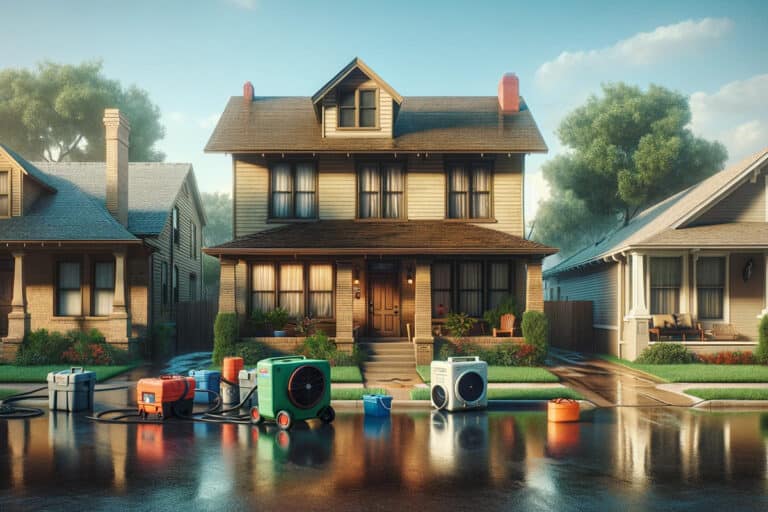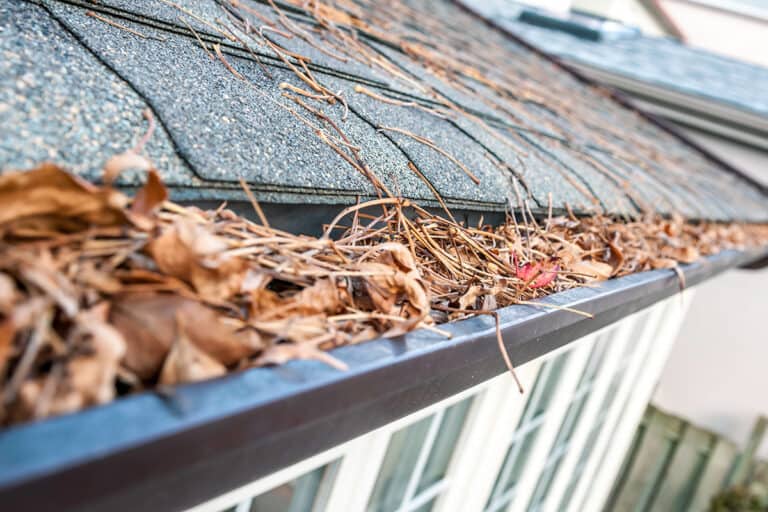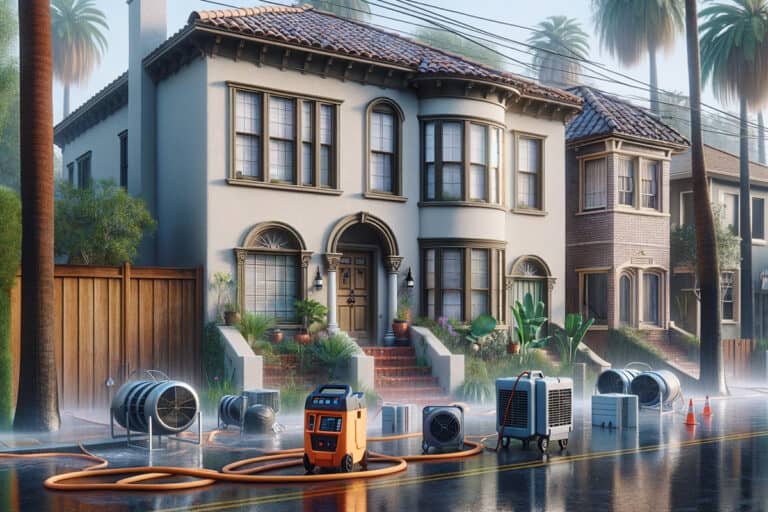Disclosure: I am compensated for purchases made through some links on this site. Click for details.
Water damage can stealthily undermine the structural integrity and aesthetic appeal of your home, leading to extensive damage and costly repairs. Whether it’s from a leaking roof, burst pipes, or flooding, water can find its way into various parts of your home, causing significant damage if not promptly addressed.
In this guide, we cover the signs of water damage in walls, ceilings, floors, roofs, windows, and doors, providing you with the knowledge needed to identify and address these issues effectively.
Signs of Water Damage in Walls
Walls are often the first place where signs of water damage become apparent, and it’s crucial to recognize these signs early to prevent further damage.
1. Discoloration
Discoloration on walls, often appearing as yellow, brown, or gray patches, is a clear indicator of water damage. This occurs when water seeps through the wall material, causing the paint or wallpaper to change color. The size and shape of the stain can give clues about the source of the water.
2. Peeling or Bubbling Paint or Wallpaper
When water infiltrates walls, it can lead to the deterioration of the bond between the paint or wallpaper and the wall itself, resulting in peeling, bubbling, or blistering. These signs should not be ignored as they indicate that there is an ongoing moisture issue.
3. Mold Growth
Mold thrives in damp conditions, and its presence on walls is a strong indicator of water damage. Look for black, green, or white spots, and be aware that mold can also produce a musty odor.
4. Musty Smell
A persistent musty smell, even if no visible signs of mold are present, can be a sign of hidden water damage and mold growth within the walls.
5. Warped or Sagging Walls
Water damage can cause walls to warp or sag, indicating that the structural integrity of the wall may be compromised.
6. Soft or Spongy Walls
Walls that feel soft or spongy to the touch are a clear sign of water damage, suggesting that the wall material has absorbed a significant amount of water.
7. Cracking or Flaking
In some cases, water damage can lead to the cracking or flaking of wall material, which can further expose the interior of the wall to damage.
8. Swelling
Swelling of the wall material is another sign of water damage, indicating that the material has absorbed water and expanded.
Signs of Water Damage in Ceiling
The ceiling is another area of your home that is susceptible to water damage, often resulting from leaks in the roof or upper floors.
1. Water Stains
Water stains on the ceiling, typically yellow or brown in color, are a clear sign of water damage.
2. Sagging Ceiling Tiles or Panels
Water damage can cause ceiling tiles or panels to sag or fall out of place, which can be a safety hazard.
3. Visible Mold Growth
Mold growth on the ceiling indicates a moisture problem and should be addressed immediately to prevent health issues.
4. Changes in Texture
A change in the texture of the ceiling, such as bubbling or peeling paint, can be a sign of water damage.
5. Dripping Water
Visible dripping water from the ceiling is an obvious sign of a significant water issue that needs immediate attention.
6. Odor
A musty or damp odor emanating from the ceiling area can be a sign of hidden water damage.
Signs of Water Damage in Floors
Floors, particularly those made of wood or carpet, are highly susceptible to water damage.
1. Buckling or Warping of Hardwood Floors
Water damage can cause hardwood floors to buckle or warp, creating an uneven surface that can be a tripping hazard.
2. Discoloration or Staining of Carpeted Floors
Water damage on carpeted floors can lead to discoloration or staining, and in some cases, a musty odor.
3. Cracks in Tile or Vinyl Flooring
Water damage can cause tile or vinyl flooring to crack or lift, indicating that the subfloor may also be damaged.
4. Changes in Floor Level
A change in the level of the floor, such as sagging or “sponginess,” can be a sign of water damage.
5. Loose Tiles or Planks
Water damage can cause tiles or planks to become loose and detach from the subfloor.
6. Distinct Sounds
Floors affected by water damage might produce unique sounds, such as creaking or popping, when walked upon.
Signs of Water Damage in Roof
The roof is a critical part of your home’s structure, and water damage here can lead to significant issues.
1. Missing Shingles or Tiles
Missing shingles or tiles can expose the roof to water, leading to damage.
2. Damaged Flashing Around Chimneys and Vents
Damaged flashing can allow water to enter the roof, causing leaks and damage.
3. Sagging or Leaking Gutters
Gutters that are sagging or not properly draining can lead to water damage on the roof and in the walls.
4. Granule Loss on Shingles
Granule loss on asphalt shingles is a sign that the shingles are deteriorating and may lead to water damage.
5. Algae or Moss Growth
The presence of algae or moss on the roof can indicate a moisture issue, which can lead to water damage.
6. Interior Water Stains
Water stains on the interior ceilings and walls directly below the roof could be a sign of a compromised roof.
Signs of Water Damage around Windows
Windows are vulnerable spots in your home where water damage can often go unnoticed until it becomes a significant issue.
1. Distorted Frames
Wooden window frames can warp or become distorted when exposed to excess moisture, hindering proper window operation.
2. Peeling Paint or Wallpaper
Water infiltration around windows can cause paint or wallpaper to peel, bubble, or blister, indicating moisture accumulation.
3. Mold Growth
Visible mold growth around window frames or on adjacent walls is a clear sign of prolonged moisture exposure.
4. Stains on Window Sills
Water stains, discoloration, or rotting wood on window sills can indicate water damage.
5. Condensation Between Panes
Double-pane windows showing condensation between the panes may have a broken seal, allowing moisture to enter.
Signs of Water Damage Around Doors
Doors, particularly exterior ones, are crucial to check for water damage to ensure they remain secure and functional.
1. Swollen or Warped Door Frames
Wooden door frames that are swollen or warped can prevent doors from closing properly, indicating water damage.
2. Discoloration
Look for any signs of staining or discoloration on the door or around the frame, which may result from water exposure.
3. Mold Growth
Mold can grow on or around doors when there is excess moisture, posing potential health risks.
4. Soft Spots in Wood
Wooden doors or frames that have soft spots when pressed may be compromised by water damage.
5. Rust on Hinges or Hardware
Excessive moisture can cause the metal hardware on doors to rust, hindering their operation and integrity.
Table 1: Checklist for Signs of Water Damage
| Area of the Home | Signs of Water Damage |
|---|---|
| Walls | Discoloration, peeling/bubbling paint, mold growth, musty smell, warped/sagging walls, soft/spongy walls, cracking/flaking, swelling |
| Ceiling | Water stains, sagging tiles/panels, visible mold growth, changes in texture, dripping water, odor |
| Floors | Buckling/warping of hardwood, discoloration/staining of carpets, cracks in tile/vinyl, changes in floor level, loose tiles/planks, distinct sounds |
| Roof | Missing shingles/tiles, damaged flashing, sagging/leaking gutters, granule loss on shingles, algae/moss growth, interior water stains |
| Windows | Distorted frames, peeling paint/wallpaper, mold growth, stains on sills, condensation between panes |
| Doors | Swollen/warped door frames, discoloration, mold growth, soft spots in wood, rust on hinges/hardware |
Table 2: Common Causes of Water Damage and Their Impact
| Cause of Water Damage | Frequency | Risk Level |
|---|---|---|
| Leaking Pipes | High | Medium-High |
| Flooding | Medium-High | High |
| Roof Leaks | Medium | Medium-High |
| Appliance Failures | Medium | Medium-High |
| HVAC System Malfunctions | Low-Medium | Medium |
| Sewer Backups/Overflow | Low | High |
| Storm Damage | Low-Medium | High |
| Poor Drainage | Medium | Medium |
How to Address Water Damage
If you suspect water damage in your home, it’s important to act quickly to prevent further damage.
- Shut Off the Water: If the water damage is due to a leak, turn off the water to your home immediately to prevent further damage.
- Contact a Plumber: Have a professional plumber find and fix the leak as soon as possible to prevent additional damage.
- Remove Wet Insulation: If any insulation has been affected by water, remove it and let the area dry out for at least 48 hours before replacing the insulation and any damaged drywall.
- Call a Water Mitigation Company: These professionals specialize in treating areas affected by water damage and can help prevent mold growth and further damage.
PREVENTATIVE MEASURES to Ward Off Water Damage
Preventing water damage requires a proactive approach, ensuring that all potential risk areas of your home are regularly inspected and maintained.
- Gutter Maintenance: Keep gutters and downspouts clean and free from debris to ensure proper water flow away from your home’s foundation.
- Regular Roof Inspections: Conduct semi-annual roof inspections to identify and repair any damaged shingles or flashing.
- Plumbing Check-ups: Have a professional plumber inspect your home’s pipes and plumbing system regularly to prevent leaks and burst pipes.
- Proper Landscaping: Ensure that the landscape around your home slopes away from the foundation to prevent water accumulation.
- Water Detection Devices: Install water detection devices near potential water sources like water heaters, washing machines, and under sinks to alert you of leaks.
By staying vigilant and conducting regular maintenance, you can significantly reduce the risk of water damage in your home.
Table 3: Water Damage Prevention Tips
| Prevention Tip | Description |
|---|---|
| Gutter Maintenance | Keep gutters and downspouts clean to prevent water accumulation. |
| Regular Roof Inspections | Inspect and repair any damaged roof shingles or flashing. |
| Plumbing Check-ups | Regularly inspect plumbing for leaks and fix promptly. |
| Proper Landscaping | Ensure landscape slopes away from the home’s foundation. |
| Install Water Detection Devices | Place devices near potential water sources to alert you of leaks. |
Common Misconceptions about Water Damage and Insurance
Many homeowners believe that their insurance will cover all types of water damage, which is not always the case. It’s important to understand your policy and what is covered.
Generally, damage from sudden and accidental incidents other than flooding is covered, while damage due to lack of maintenance may not be. Keep thorough records and take photos of the damage for insurance claims.
Flood insurance is a separate policy. Water damage from a flood is not typically covered by your homeowner’s insurance policy.
Additionally, some people may think that a small leak isn’t a big deal, but even small amounts of water can lead to significant damage over time.
Health and Safety
Water damage, if not promptly addressed, can lead to a host of health and safety issues, particularly when mold is involved. If you suspect mold growth, it’s important to address the issue immediately. In cases of significant water damage, it may be best to call in professionals to ensure that the cleanup is done safely and thoroughly.
- Mold and Mildew: These fungi can start growing within 24-48 hours in a damp environment, leading to respiratory issues and other health problems.
- Structural Safety: Water damage can compromise the structural integrity of your home, making it unsafe to inhabit.
- Electrical Hazards: Water and electricity are a dangerous combination. Ensure that power is turned off in any areas affected by water damage.
It is paramount to prioritize health and safety by addressing water damage immediately and considering professional help when necessary.
Professional Help and When to Seek It
For extensive water damage or when mold is present, it’s best to call in professional restoration services. Look for companies that are licensed and insured, and check for certifications from organizations like the Institute of Inspection, Cleaning and Restoration Certification (IICRC).
Understanding when to call in professional help can be the key to effective water damage restoration.
- Extensive Damage: If the water damage is too extensive to be handled with DIY methods, professionals have the necessary tools and expertise.
- Mold Presence: If you see or suspect mold, professionals can safely remediate it.
- Uncertain Source: If you’re unable to identify the water source, professionals can help locate and repair it.
Look for certified professionals who specialize in water damage restoration to ensure the best outcome.
Long-Term Effects of Water Damage
If not properly addressed, water damage can lead to long-term structural damage and potential health issues related to mold. It can also decrease the value of your home.
- Structural Damage: Over time, water can weaken the structural elements of your home, leading to potential collapse.
- Decreased Property Value: Homes with a history of water damage may be valued lower on the market.
- Chronic Health Issues: Prolonged exposure to mold can lead to respiratory and other chronic health issues.
It’s crucial to address water damage promptly to avoid these long-term effects.
Environmental Impact
Water damage not only affects individual homes but can also have broader environmental impacts.
- Resource Depletion: Extensive repairs require materials and energy, contributing to resource depletion.
- Waste Generation: Damaged materials contribute to waste, and it’s important to dispose of them responsibly.
- Floods and Natural Habitats: In cases of flooding, natural habitats can be disrupted, and contaminants can spread to water sources.
Considering the environmental impact of water damage and restoration is essential in promoting sustainable practices.
FAQs About Signs of Water Damage in Walls, Ceiling, Floors, and Roof
Conclusion: What Does Water Damage Look Like
Water damage can have serious consequences for your home, but early detection and prompt action can help mitigate the damage and protect your home’s integrity. By being vigilant and recognizing the signs of water damage in walls, ceilings, floors, roofs, windows, and doors, you can address issues promptly and minimize their impact. Remember to act quickly if you suspect water damage and consult with professionals to ensure that the issue is resolved properly and safely.





